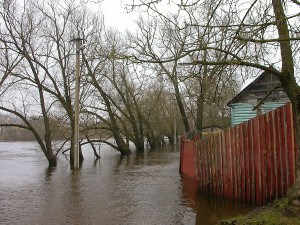Seven years after Hurricane Katrina devastated New Orleans, inspectors taking the first-ever inventory of flood control systems overseen by the U.S. government have found hundreds of structures at risk of failing and endangering people and property.
Levees deemed in unacceptable condition span the breadth of America. They are in every region, in cities and towns big and small.
The U.S. Army Corps of Engineers, the federal public engineering agency, has yet to issue ratings for a little more than 40 percent of the 2,487 structures, which protect about 10 million people. Of those it has rated, however, 326 levees covering more than 2,000 miles were found in urgent need of repair.
The problems are myriad: earthen walls weakened by trees, shrubs and burrowing animal holes; houses built dangerously close to or even on top of levees; decayed pipes and pumping stations.
Local governments are responsible for upgrading unacceptable levees. Some local officials say that the Corps is exaggerating the dangers, that some deficiencies were approved or not objected to by the federal government and that any repairs could cost them hundreds of thousands, if not millions, of dollars.
“It’s just not right to tell a little town like this to spend millions of dollars that we can’t raise,” said Judy Askew, mayor of Brookport, Ill., a hardscrabble town of about 1,000 on the banks of the Ohio River.
 The condition of flood control systems came into dramatic focus in August 2005 when Hurricane Katrina’s rain and storm surge toppled levees in New Orleans and tore up the Gulf Coast. It left 1,800 people dead and was the costliest storm in U.S. history with damage estimated at $108 billion.
The condition of flood control systems came into dramatic focus in August 2005 when Hurricane Katrina’s rain and storm surge toppled levees in New Orleans and tore up the Gulf Coast. It left 1,800 people dead and was the costliest storm in U.S. history with damage estimated at $108 billion.
Afterward, Congress told the Corps to catalog federally overseen levees, many of which it built and handed over to municipalities to run and maintain. The Corps has spent more than $140 million on inspections and developing the inventory.
As of Jan. 10, the agency had rated 1,451 or 58 percent, of them. Of those, 326 were unacceptable, 1,004 were minimally acceptable with deficiencies that need correcting, and 121 were acceptable.
In interviews, some local managers disputed their “unacceptable” ratings, saying their levees were sound, if not perfect.
Bill Sheppard, assistant chief engineer for the Yazoo-Mississippi Delta Levee Board, noted that none of its levees failed during severe flooding in spring of 2011. “Our system works,” he said. “Does it have components that need to be fixed after this flood? Absolutely. But if you look at the levee evaluation reports, you’d think, ‘Oh Lord, run for the hills.”‘
A number of local managers blame their “unacceptable” ratings on the Corps taking a harder line on compliance with levee construction, operation and maintenance standards.
“Since Katrina, they’re almost hyper-vigilant,” said John Sachi, city engineer for South St. Paul, Minnesota. “It’s almost like they’re remedying their mistakes from the past by putting the onus on us to make sure things get better.”
Eric Halpin, the Corps special assistant for dam and levee safety, agreed that levees covered by the agency’s safety program mostly held their own during some of the heaviest flooding on record in 2011, which caused an estimated $9 billion in damage.
But that doesn’t mean inspectors are overstating the system’s flaws, Halpin said, noting that some communities escaped catastrophe only after heroic efforts to shore up levees more than half a century old.
(John Flesher reported from Brookport, Illinois, and Traverse City, Michigan, and Cain Burdeau reported from New Orleans. AP reporter Troy Thibodeaux contributed from New Orleans and AP video journalist Haven Daley contributed from Sacramento.)
Was this article valuable?
Here are more articles you may enjoy.

 Florida And East Coast Will See Big Losses From More Cat 5 Storms, Researchers Say
Florida And East Coast Will See Big Losses From More Cat 5 Storms, Researchers Say  Toyota Unveils Concept LFA Supercar, and It’s Fully Electric
Toyota Unveils Concept LFA Supercar, and It’s Fully Electric  Hermès Heir Sues Arnault and LVMH in $16 Billion Suit Over Lost Shares
Hermès Heir Sues Arnault and LVMH in $16 Billion Suit Over Lost Shares  California Again Delays Wildfire Protection Rules for Homes
California Again Delays Wildfire Protection Rules for Homes 